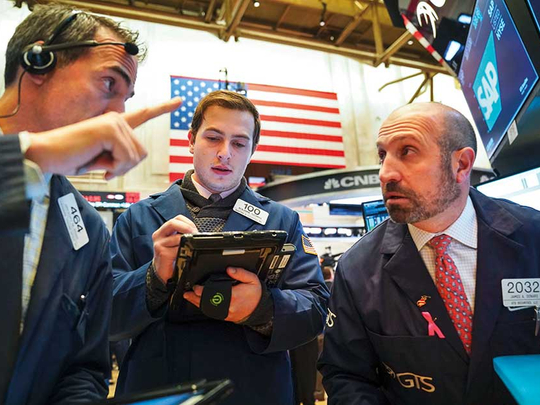
Package maker Sealed Air Corp. fell the most in six months on Thursday after saying higher raw material costs would crimp the bottom line.
A few days earlier, it was rising freight outlays at Fastenal Co., where $1.1 billion (Dh4 billion) of market value was erased. On October 9, paint maker PPG Industries Inc. mentioned rising expenses. The shares cratered.
From railroads to retailers, signs of price pressures are starting to show at US industrial companies, contributing to the worst October start for the S&P 500 since 2008. Equities have had their three worst sessions since April in the space of eight days, narrowly escaping a fourth straight down week thanks to a Thursday rally.
An earnings season everyone hoped would restore order has instead sent signals that the future is murkier than bulls realised, particularly on the inflation front, where many of their nightmare scenarios reside.
“That doesn’t necessarily mean that we fall into a recession, but it should slow growth,” said Matt Maley, equity strategist at Miller Tabak & Co. “That is not good for a stock market that had been priced for perfection just a few weeks ago.”
It’s not that earnings are weak. S&P 500 companies are on pace to expand profit by 20.7 per cent in the June-September period and are headed for the biggest annual increase in eight years. The problem is the high hopes built into stock prices. Any sign rising costs are eroding the bottom line are ringing alarm bells for investors who have pushed stocks up 50 per cent over 30 months.
“This leaves little room for a hiccup in the economy,” said Chad Morganlander, portfolio manager at Washington Crossing Advisors. “The environment is changing and yields are at the highest level they’ve been in a decade. This confluence of factors isn’t a good one.”
Concerns like these may seem overstated in an economy where unemployment is at a 48-year low and consumer confidence a two-decade high. But investors with a sense of history are aware readings like these are more common at the end of rallies than the beginning.
Throw in President Donald Trump’s trade war, currency weakness in emerging markets and a still-hawkish Fed, and it’s a recipe for turbulence. The Chicago Board Options Exchange (CBOE) Volatility Index has averaged 17.2 in October, up 33 per cent from the previous month.
Among the casualties:
In a flat week for the S&P 500, old economy stocks bore most of the losses. Energy shares slid 1.9 per cent, commodity producers lost 1.4 per cent, and industrial companies fell 1 per cent.
The S&P 500 Industrials Index is down 3.6 per cent in 2018, compared with a 3.5 per cent gain in the full index. Active manager ownership of in the group was at the lowest level since 2008 in August, Bank of America’s data show.
Tighter margins go hand in hand with a market villain already on bulls’ radar, rising interest rates, themselves a consequence of a strengthening economy and eight Federal Reserve interest rate hikes since 2015. While not a margin story per se, nowhere is the spectre of rising borrowing costs more pronounced than in homebuilder stocks. The largest exchange-traded fund tracking the sector has spent 22 out of the past 25 sessions in the red, losing almost 20 per cent of its market value in just a month.
Bank of America strategists including Ronan Carr say weakness is a buying opportunity. They’re telling clients to go long industrials versus the broader US market amid bets the headwinds are priced in and the sector will benefit from the bull market broadening out.
“While the trade clearly also has some correlation to the evolution of the global cycle and trade war risks, the sector exhibits strong fundamentals but has de-rated versus the US market,” Carr said in a note on Friday. “The sector is a beneficiary of the capex upcycle we are seeing in the US, something our economists expect to continue.”
Margin pressure has been one of many sagas in the industrial space of late. Earnings-related concerns going beyond rising costs have been leading to intermittent blow-ups around the industry for weeks, in companies from United Rentals to Textron Inc. and Snap-On Inc. Outside of the US, shares of Daimler AG fell on Friday after the automaker issued its second profit warning in four months.
“It doesn’t mean the economy is going through a recession, but it’s reality when the supply of labour tightens; labour is emboldened to seek higher wages, and business have to pay more,” said Marshall Front, CEO and chairman of Front Barnett Associates LLC. “And the same time, demand is tight for raw materials, fees go up and prices go up. It’s not the end of the world, it’s something businesses have to contend with.”












